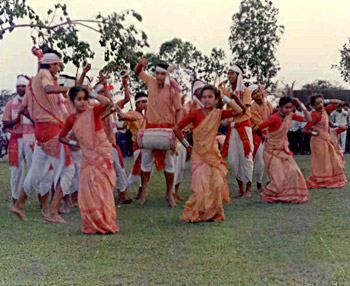 Sung and composed by the rural folk, Folk Songs on Seasons are infused with the hues of agriculture. The various seasons herald the advent of various work situations for them and the change of seasons is celebrated with much dance and song. For instance, the Chait Parab of Orissa, a spring-festival, has given rise to a rich collection of songs; the peasant sings as he works in the field.
Sung and composed by the rural folk, Folk Songs on Seasons are infused with the hues of agriculture. The various seasons herald the advent of various work situations for them and the change of seasons is celebrated with much dance and song. For instance, the Chait Parab of Orissa, a spring-festival, has given rise to a rich collection of songs; the peasant sings as he works in the field.
"The lower leaf drops, the upper leaf laughs, and the middle one says: My day draws nearer."
Similar celebrations of seasons and the various references to seasonal changes are seen in a variety of folk songs sung in different parts of the country. The Kol tribe of Chota Nagpur has its own nature-dances, enacted round a cut branch of the karma tree. The Majhwar enacts the dance when the monsoons come as well as monsoons end. Other Chota Nagpur tribes do it in the middle of the rain, in August, when the crops spring up in the field and they celebrate the joy of creation. The Hill Bhuiyas of Orissa do it when the crops are harvested. The Bihu dance of Assam celebrates the joy of nature and creation in the middle of April before the onset of the monsoon.
All these nature-festivals have fertility of the earth as the theme. The primitive man regarded fertility as a blessing which was granted by the Gods and felt that they needed to be appeased with song and dance so that they would grant the gift of fertility to man. For instance, according to Telugu folk-lore, there is a Harvest-God whose blessings are necessary for a bountiful crop. He is called Poli, and more familiarly Yaggenna. Thus, for instance, there is a nature-festival of the Uraons in which the fertility-theme dominates. The seed is sown in moist, sandy soil, mixed with a quantity of turmeric, and the blades sprout and unfold a pale yellow colour. On the karma day, these blades are taken up by the roots, as if for transplanting, and carried in baskets by the fair cultivators to the Akhra. The "fair cultivators" carry cucumbers in their baskets, a fertility symbol.
For cultivation, rains are essential; they fertilize the earth. This has deeply occupied the imagination of the folk-people. For instance this Baiga song:
Which cloud rains?
Which cloud roars?
The white cloud roars,
The dark cloud rains,
The cloud rains and helps the corn,
The world lives on the corn.
Similar instances of the importance and symbolism of rain are found in folk songs from all over the country- In Bihari folk songs, Tamil folk songs and lots more.
The seasons are celebrated in a variety of ways; each season leaves its own impressions on the folk-mind and has produced seasonal songs of nature. Known as Phalgun, Magh, Pus etc each season brings with it own set of changes. They are known as Bara Masi songs in Orissa, and Bara Mahi songs in Assam. Some of these songs have love as the theme while their mission is to welcome the rain. There are two different cycles of seasonal songs in Bhojpuri language. One of them is sung in Chart; the songs are called Ghatos. The other cycle is sung during the rains; this is called Kajri. In Bihar, the Kajri songs are generally sung by Hindu women of the higher castes.




















